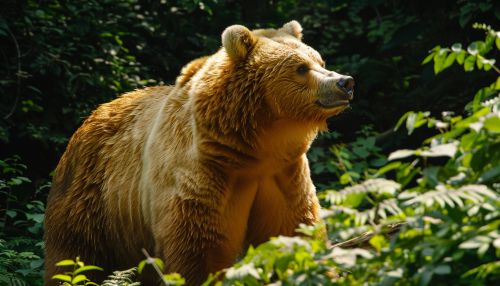Golden Bears
Overview
The Golden Bears are a group of large, predominantly terrestrial mammals that belong to the family Ursidae, specifically the genus Ursus, and are characterized by their distinctive golden or light brown fur. They are found in various parts of the world, including North America, Europe, and Asia. These bears are known for their strength, agility, and adaptability, making them one of the most respected and feared animals in the wild. Biologically, they are classified as omnivores, consuming a wide variety of food sources depending on their habitat and the season.


Biology and Behavior
Golden Bears, like all members of the Ursidae family, are large-bodied animals with robust skeletal structures. They possess a broad head with small ears, a wide, short neck, and a large, powerful body with a hump of muscle mass over the shoulders. Their fur color ranges from light golden to dark brown, giving them their common name. The fur serves not only as a means of camouflage but also as insulation against harsh weather conditions.
Golden Bears have a keen sense of smell, surpassing that of dogs, and are capable of detecting food, mates, and danger from miles away. They have relatively poor eyesight and rely heavily on their sense of smell and hearing.
In terms of behavior, Golden Bears are generally solitary animals, with males and females coming together only during the mating season. They are not territorial but do maintain home ranges that they defend from other bears. They are primarily nocturnal but can be active during the day, particularly in human-dominated landscapes to avoid conflict.
Diet
Golden Bears are omnivorous in nature, with their diet varying greatly depending on the season and their habitat. They consume a wide variety of foods, including berries, grasses, roots, insects, fish, and small to medium-sized mammals. They are also known to scavenge on carrion and are capable of bringing down large prey such as elk or moose.
During the fall, Golden Bears enter a period of intense eating known as hyperphagia, during which they can consume up to 20,000 calories a day to prepare for hibernation. This is a crucial time for the bears, as they need to build up sufficient fat reserves to survive the winter months when food is scarce.
Habitat and Distribution
Golden Bears are found in a variety of habitats, from the icy tundra of the Arctic to the dense forests of North America and Europe, and the mountainous regions of Asia. They are highly adaptable and can survive in a range of environmental conditions, although they prefer areas with dense cover where they can hide from potential threats.
The distribution of Golden Bears is largely determined by the availability of food sources. They are typically found in areas with abundant natural resources, particularly those with a high density of berry-producing plants and rivers teeming with fish.
Conservation Status
Golden Bears are currently listed as a species of least concern by the IUCN, due to their wide distribution and relatively stable population numbers. However, they face numerous threats, including habitat loss due to deforestation, conflict with humans, and climate change.
Conservation efforts for Golden Bears are focused on protecting their habitats, reducing human-bear conflicts, and ensuring sustainable population levels. This involves a combination of legal protection, habitat management, and public education to promote coexistence with these majestic creatures.
